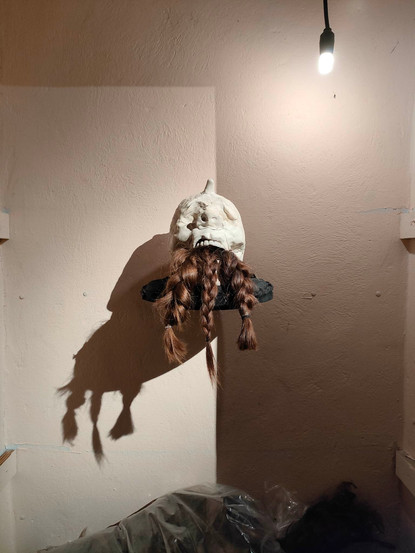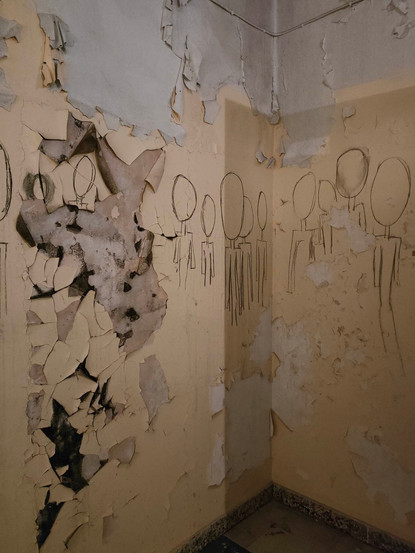Taking a look back to "Egkleismoi" exhibition.
- Elena Tsavdari

- Jan 19, 2024
- 4 min read
Art and mental health have been subjects of concern for researchers since the 19th century. Psychiatrists and artists have studied this matter, exploring factors such as the Romantic movement in the 1800s, the search for different modes of artistic expression in the 20th century, and movements like Dada and post-modern art. These movements brought attention to the art created by mentally ill individuals within the context of creativity in mental institutions.
Historians have shown interest in this subject, posing questions such as the reasons behind the production of this kind of art, what it can reveal about life in mental institutions, and why views on it have changed over time. Of course, things have evolved since the 19th century when these studies began. Conditions in mental institutions have improved, and patients no longer receive the same (mal)treatment from medical professionals and society. However, things are far from perfect, and there is still ample room for improvement.
Now let’s talk about an exhibition that addressed these issues in a really interesting way. "Egkleismoi" (meaning "confinements") was an exhibition that took place in Athens in December 2022, focusing on these kinds of topics. The inspiration for the exhibition arose during the COVID-19 pandemic and was based on a collection of interviews with patients, doctors, and nurses. The exhibition was hosted in three buildings of Dromokaitio mental hospital; two of the buildings are abandoned, while the other has been transformed into a museum.
The exhibition aimed to study and document both real and symbolic incarceration, examining opposite poles such as sickness/health, realities/imaginary scenarios, truth/lies, inside/out and incarceration/freedom.
Some of the questions posed in the report concern the nature of confinement and what it is like to be literally trapped in a cell, a hospital room, or a correctional facility. The report also explores the metaphorical and symbolic meaning of confinement, as the project aimed to address the issue of the pandemic experienced by society both domestically and globally.
At the same time, the goal of the exhibition was to highlight the history and significance of Dromokaiteio, as the first psychiatric hospital in Greece that was established from the beginning based on French models considered innovative in the field of psychiatry at that time.
Fourty eight artists participated in the exhibition with sculptures, installations, video art, sound installations, paintings and photography. The criteria of choices was the artworks to respond to the exhibition space and the context.
Daftseion was the building where the most economically stable patients were being hospitalised, the ones whose families were able to afford the high hospital fees. These patients were lucky to be treated with modern therapy methods like psychotherapy, art therapy and music.
Agios Isidoros was the building where poor and "difficult" patients were held. It was built in 1892 and it had small rooms with skylights and railings. There was also a dining room in the building where the patients who were considered "well-behaved" and well- functioning used to gather and eat.
The third and final building that housed the exhibition is the Old Hospital Printing House, which is the only one among the three buildings that has not been abandoned and it is currently used as a museum.
The goal of the exhibition was to begin with the space and end with the space, simultaneously addressing the theme, without letting the space overshadow the exhibition and the artworks themselves.
The impact of time is naturally evident in the two abandoned wings, giving them a unique and somber atmosphere. In the case of Daftseion, the grandeur once held by the space has been lost, and the viewer's exploration of the space highlights the neglect and abandonment of the building, bringing the revival of its history through the exhibition. As for Agios Isidoros, the atmosphere is even more gloomy and stifling, as the building has undergone such significant decay and distortion that it resembles a scene from a movie, especially if one visits the exhibition during the evening hours.
Certainly, the choice of such a space, with a heavy history and hard memories where traces of its previous use are visible, entails risks. The most significant of these is undoubtedly the potential for the psychiatric clinic to be aestheticized, becoming a unique and sensational spectacle for the public, without conveying its history as a space of isolation loaded with memories, personal stories, and testimonies of real people. It is evident that the abandoned spaces of Dromokaiteio emit a sense of mystery, like all abandoned spaces with such histories that have deteriorated over time. Therefore, the dilemma arises as to whether the use of the space aims at the allure of the viewer's gaze or at projecting it as a field of disturbance and conflict, with the purpose of highlighting history through the lens of art and the questions raised by the exhibited works.
From the works of the artists who participated in the project, many conclusions emerge, and various concepts are addressed. Many of the artworks are based on real events and actual testimonies of people, as well as on practices used on psychiatric patients that are inhumane and violate human dignity. Throughout the collection, issues such as stigma, class differences (clearly evident in the separation and differentiation of the two wings of the hospital), social exclusion, personality deconstruction, marginalization, and the withdrawal of the individual from society are highlighted. The artworks also touch upon digital confinement and the revelation of the undignified living conditions, abandonment, and complete institutionalization of patients, with the island of Leros being a prominent example.
The exhibition manages to address in a direct and straightforward manner the issues of various confinements, separations, class differences, institutionalization, stigma, and the deconstruction of individual personality. The approach to such a broad theme through the artworks, their communication with each other, and their interaction with the audience can be described as not only sensitive but also raw and intense. There is an atmosphere of revelation and rebellion against inhumane practices, segregations, and affronts to human dignity.
Many artworks are somber, dark, and revealing, while others are sensitive and even evoke a sense of childhood, which stands out in the overall atmosphere, providing a different perspective on the issues. The exhibition space communicates and gives meaning to the works in many instances without overshadowing them. The concept of dystopia is evident in the project, and the result is visually impressive without sacrificing the conceptual background and the nuanced approach to the difficult issues discussed in relation to the history and memories of the institution.
References:



























Comments